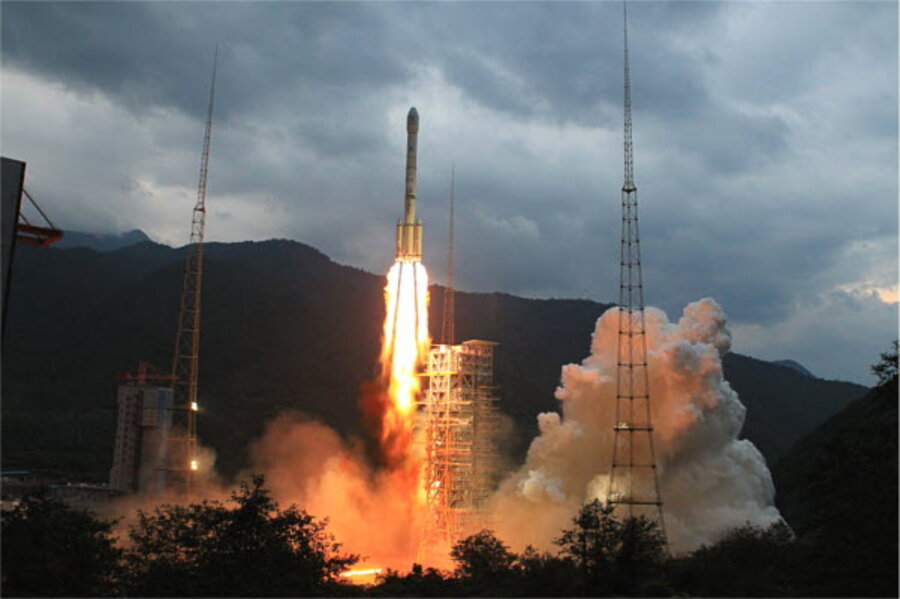China steps up the space race: A rover is heading to the moon
Loading...
China will send a rover to the moon by the end of the year, officials announced Wednesday. Though it was originally slated for September, officials are now planning to launch early December 2 local time (December 1 in the US).
"The Chang'e-3 mission makes best use of a plethora of innovative technology. It is an extremely difficult mission that carries great risk," said Ma Xingrui, head of China's space exploration body and chief commander of the lunar program.
Unlike early NASA rover missions to Mars, the Chang'e-3 rover won't bounce or hang-glide its way to the surface (the latter wouldn't work anyway, as the moon has virtually no atmosphere). Instead, it is planning for a "soft landing," says Dr. Ma, using thrusters to gently lower the lander onto the moon's surface, like the Apollo landers of the 1960s and 70s.
Chang'e (pronounced Chong-eu, where the first syllable rhymes with "long" and the second syllable is like vowels at the end of "chauffeur") is named for a figure from Chinese mythology. Unlike Greek and Roman moon goddesses, Chang'e is not, herself, the moon; instead she lives there, having floated away from Earth after consuming a double-portion of an immortality elixir.
"The Chinese, far and away, have the most stable and most robust lunar exploration program of any country in the world right now," says Chuck Wood, a senior scientist at the Planetary Science Institute in Tucson and creator of the popular Lunar Photo of the Day website. The European Space Agency, India, and Japan all flew successful missions to the moon in the past decade, he says, but none of them have serious plans to continue exploring the moon. "But China does."
This mission is the third in a carefully planned sequence. "When China decided it wanted to start exploring the moon, it decided to do it in three steps," says Phil Stooke, author of the International Atlas of Lunar Exploration. "Orbiting, landing, and then bringing material back. And for each of those stages, they're going to have two spacecraft," where the second can replace the first in case of failure or extend the mission if it's a success.
Step one: Orbit the moon, taking pictures and measurements. Chang'e-1, launched in 2007, created a complete photographic mosaic of the moon. Three years later, Chang'e-2 took higher-resolution images of the whole planet and created a very high-definition map of Sinus Iridium, where Chang'e-3 hopes to land. Once it had completed its lunar goals, Chang'e-2 left the moon and visited a Lagrangian point and then flew by an asteroid, as the controllers back on Earth practiced their remote steering, navigation, and deep-space tracking.
Step two: Land on the moon. Chang'e-3 includes a lander and a rover, and Chang'e-4 is on deck "as a backup, in case the first one doesn't work," says Dr. Stooke, who teaches physics and astronomy at the University of Western Ontario. "If the first one does work, they'll send the second one to a different place."
Once Chang'e-3 lands, it will release a rover to wheel around the moon's surface and gather information about Sinus Iridium and nearby areas. The rover's batteries will be charged by a panel of solar cells during the 14-day lunar day and by plutonium-238 during the lunar night, when temperatures drop below -170 Fahrenheit, a Chinese news source announced earlier this month.
The rover and lander will survey territory, assess living conditions, and make other observations, announced Ye Peijian, chief commander of Chang'e-3, in a statement earlier this year. The reference to living conditions is one of many hints that the Chinese are dropping that this lander marks a step towards eventual human exploration of the moon.
But first, assuming the lander and rover technology work successfully, they'll move on to Step 3, says Stooke: "Landing, scooping up surface material, and bringing it back to the Earth," probably in 2017.
Though China hasn't announced an official plan for human exploration of the moon, their unofficial timeline is aiming at the mid-2020s, says Dr. Wood. So far, China's human spaceflight program has conducted 11 missions, including five with people aboard. Ten Chinese astronauts – eight men and two women –have flown in space, on shuttles and aboard the Chinese space station.
NASA has played no role in any of these missions. In fact, federal law prohibits NASA from direct involvement with China's space program, so Chinese scientists have built on Soviet and Russian spaceflight technology to design the thrusters, rovers, communications, other components of a successful mission to the moon.
"NASA congratulates any peaceful demonstration of humankind's ability to explore the heavens," the space agency said in a statement. "The United States has been engaged in the peaceful exploration of space for more than 50 years, and we welcome other nations that wish to join this endeavor."








